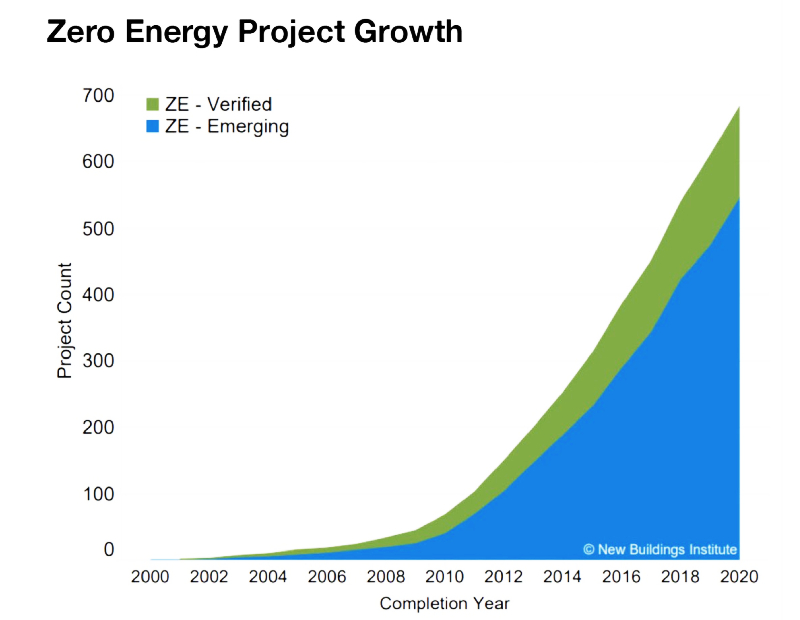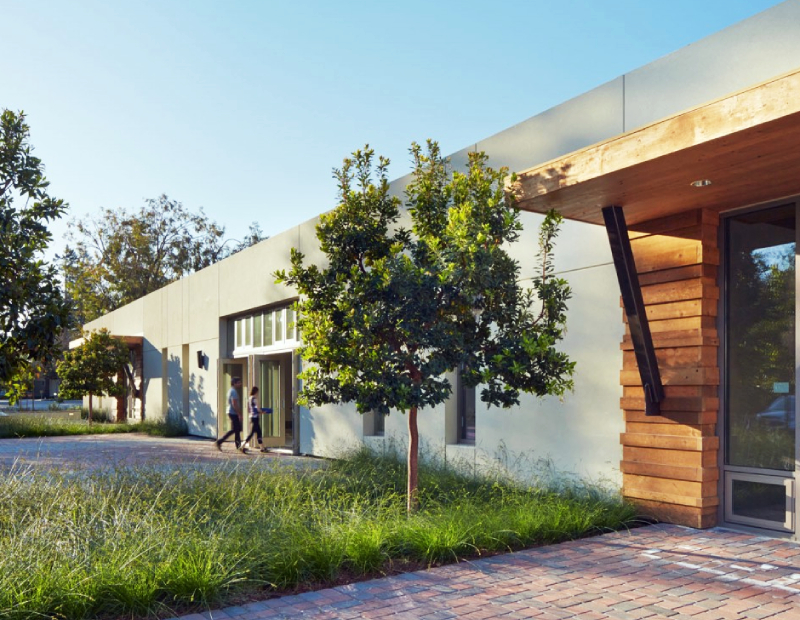Zeroing In on Net-Zero Energy Buildings
Commercial buildings using only as much energy as they produce are growing in number, boosted by incentives and local goals.

Zero Energy Project Growth from 2000 to 2020. Chart courtesy of the New Building Institute
Net-zero energy buildings are gaining popularity across North America, a sign of both property owners’ commitment and the growing availability of resources to deliver on owners’ zero energy targets. In its 2020 Getting to Zero Buildings List, the Portland, Ore.-based New Building Institute stated that the nearly 700 verified and emerging North American zero-energy buildings represent a 42 percent increase over 2018. Total square footage of zero-energy buildings has passed 62 million, a leap of 39 percent from 2018, NBI estimates in the report, which was released in late September.
A verified zero-energy building consumes only as much energy as it produces with clean renewable energy. Emerging zero-energy buildings have set goals of zero energy, but have yet to be completed or achieve zero-energy performance, according to NBI.
READ ALSO: Net Zero as the New Standard
All three types of commercial buildings—single-tenant, multi-tenant and mixed-use—can attain net-zero levels, depending on ownership and tenant structure.
The best candidate is a single-tenant, owner-operated building with a longer time horizon. “The owner-operator basically realizes the benefits in energy savings, cost savings and the non-energy benefits to the tenants,” NBI CEO Ralph DiNola told Commercial Property Executive.
Split energy incentives can be overcome through leasing structures. Ownership pursues a green leasing approach, clearly defining zero-energy performance goals. It gives tenants an understanding of the energy budget for their spaces and the terms for exceeding or being under budget. “What we’ve seen is that, in many projects achieving zero-energy performance, like-minded tenants have the same objectives as the owner,” DiNola said. “They share those goals and it becomes more of a mutually agreed-upon approach.”
Equal Opportunity
Any building can achieve zero energy by balancing energy consumption and production, according to Carmel Pratt, director of new construction with Bright Power, a New York City-based energy and water management services provider.
Properties particularly well-suited to achieving net-zero balance are ultra-low-energy-consuming buildings that typically have higher performance thermal-enclosure systems, high-efficiency MEP systems and on-site renewable energy generation, Pratt noted.
Zero energy can be achieved more readily in new-construction buildings where designers enjoy a blank canvas, without the existing conditions presented in a renovation scenario. Even a particularly challenging existing building can achieve net-zero energy with the right design methods and construction practices.
“Achieving net-zero energy use in building renovations is particularly important in regards to the topic of embodied carbon—an urgent and equally critical component of the building sector’s impact on greenhouse gas emissions and climate change,” Pratt added.
READ ALSO: Energy Awareness Brings Savings During COVID-19
In existing buildings, an audit or energy modeling should be completed first, said DiNola. The exercise produces insights into a variety of areas, including the building’s performance; the building envelope’s condition and possible improvements; whether the HVAC system should be modified, upgraded or changed completely; and how controls should be updated or changed.
Whether the building is new or existing, it is difficult to make it a zero-energy building unless enough renewable power can be generated, observed Wayne Turett, founder & principal at The Turett Collaborative, a New York City-based architecture and design firm. For instance, the compact footprint of a 20-story New York City office tower might lack enough roof area for solar panels. “Take the same 20-story building and lay the square footage on a one-story building, and you’d have the needed area for the panels,” Turett added.

435 Indio Way in Sunnyvale, Calif. Image by Bruce Damonte
An example of a transformation into a zero-energy certified building can be found at 435 Indio Way in Sunnyvale, Calif. The retrofit of a 1970s square, one-story office building employed passive or bioclimatic design strategies incorporating highly insulated ceiling and walls, 43 custom skylights designed by Integral Group, integrated rooftop photovoltaics, solar gain from all building apertures, natural ventilation for most cooling requirements and the addition of fans for increased comfort control.
Local Regulations
Do local policies impact increases in zero energy buildings?
North American states and provinces that set climate action goals—primarily on the West Coast and the northeastern U.S. —lead the market in zero energy buildings, Pratt said. “Local policies have historically dictated market transformations related to building energy and will continue to do so as jurisdictions develop legislation not only responding to the climate crisis but proactively setting targets and metrics for meeting and exceeding future climate goals,” she added.
According to Pratt, programs such as RetrofitNY and other funding-incentive mechanisms, typically administered by utility companies and energy service companies, continue to drive adoption of net-zero and low-carbon buildings, providing subsidies for early adopters of more stringent building energy goals.







You must be logged in to post a comment.